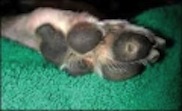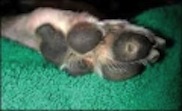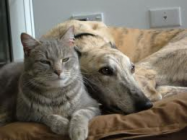
Commonly Treated Conditions with Homeopathy
|
||||||||||||||||||||||||

FACT FILE: A little about Corns


What are corns and where do they come from?
Corns are hard protuberances that appear on the pads of greyhound feet. They may initially present as a tiny dot that eventually gets bigger until the corn breaks through the pad. This may include thickening of the digital pad, firm tissue palpable in the pad, pain on pressure across the pad as well as directly over the corn, lameness, and sometimes a penetrating wound is visible.
They can grow quite large if left unchecked and are extremely painful for greyhounds. Imagine walking around with a pebble in your shoe that you cannot get rid of. Add that to the multitude of nerve endings in dog feet and you will get some idea of why they are so painful.
There are various theories for reasons for corns. One thought is that a corn is caused by a foreign object imbedding in the pad, and the pad forming a hard callus around the object. Another theory is that greyhounds do not have enough fat cushion in their toe pads, and the corn is caused by pressure between the toe bone and pad. Finally, there is the belief that they are caused by an infection associated with the papilloma virus causing an 'ingrown wart' in the pad. However a recent research paper published in the USA concluded that there was little or no evidence for this assumption. Tests were performed to look for viral DNA evidence from affected dogs but no evidence of viral presence was noted.
My own research based on my experience has concluded that in the majority of cases, most have been as a result of trauma from penetrating wounds associated with sharp objects, eg. glass debris, splinters etc which are more likely to penetrate through the pad into the sensitive tissue below, imbedding in the pad, and forming a hard callus around the object. Greyhounds have much thinner skin hence the probable cause of the higher incidence in this breed. These thinner pads are more prone to bruising and haemorrhage into the deeper pad tissues which can subsequently lead to thickening.
A significant number of over 500 greyhound owners who have successfully used my treatment have all reported some form of foreign material pushing through from the pad after the corn has came out.
How do I know if my dog has a corn?
If you find your dog has come up lame, it is always wise to check the feet first and foremost. Corns are generally round in appearance and may have raised edges or a pale ring around them. They are particularly characterized by your dog's seeming soundness on softer surfaces, including grass and carpet, but lameness on harder surfaces such as concrete, asphalt and gravel. You may notice that your dog is choosing to walk on grass as opposed to pavement on walks.
Upon inspection of the dog's feet, you may notice a lesion. To see if it is a corn have your dog stand up and pick up the foot. Grasping the toe from each side give it a firm but gentle squeeze. If it is a corn, your dog will likely pull back his foot. Additionally, when you release the paw, he may be reluctant to put weight on the foot. Again, corns may be very small to very large so do a careful inspection of each toe. Even the tiniest of corns can cause a great deal of pain and discomfort. If you are struggling to see a corn in your dog's pad, it may be easier to spot if the pad is wet.


